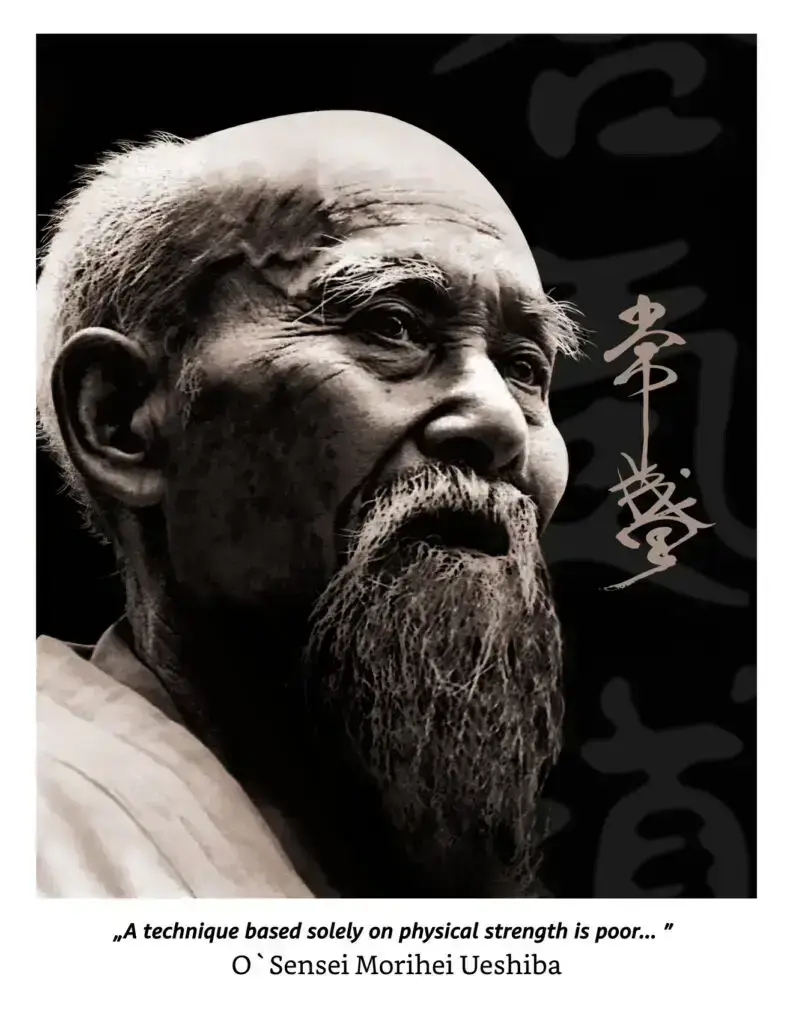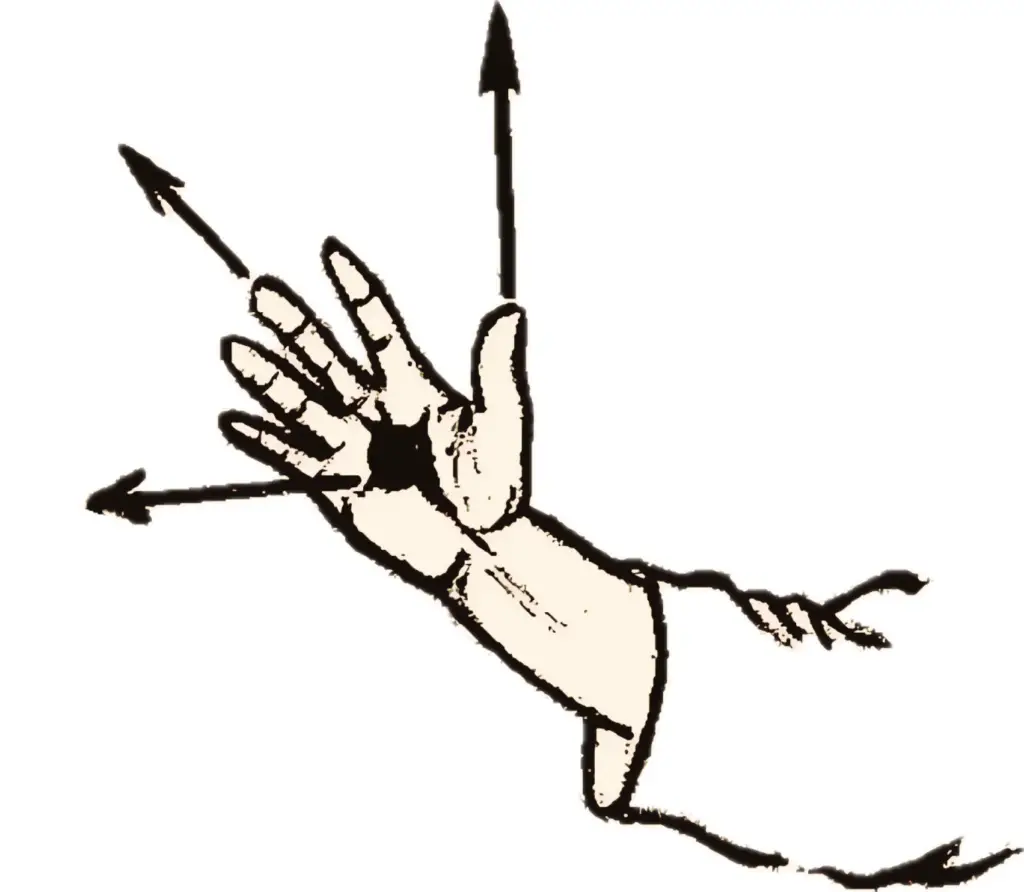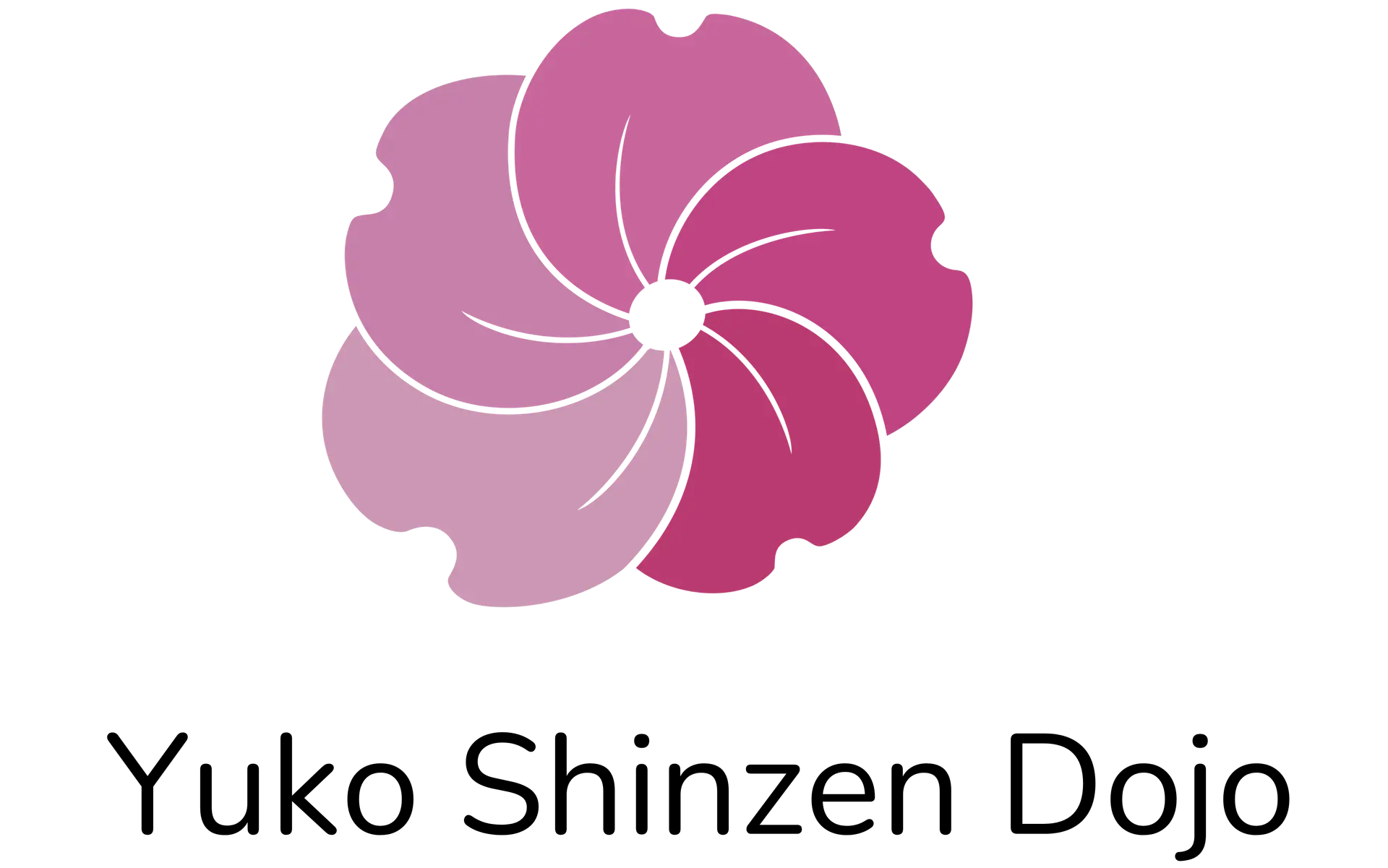AIKIDO
The Spirit of Aikido

Source: The samurai in the service of peace by Bartosz Ciechanowicz
Aikido
The Philosophy
Aikido is not simply a method of self-defense — it is a path of personal transformation. It does not rely on trickery, deception, or brute force to overcome opponents. Instead, Aikido teaches us to resolve conflict through harmony, balance, and natural movement.
Rather than resisting force, we learn to guide and redirect it — dissolving confrontation without aggression. Effectiveness in Aikido comes not from muscle, but from the unity of mind, body, breath, and awareness. Through this unity, practitioners align themselves with nature’s flow — moving with energy, not against it.
Over time, dedicated training cultivates calm, adaptability, and clarity. We become able to respond to any situation without fear, tension, or domination — but with presence, grace, and purpose.
This section explores the mindset at the heart of Aikido: from the open and flexible mind (Jūnan na Kokoro), to the immovable center (Fudoshin), and the deep clarity of Sumikiri.
Before the hands move, the heart must know peace.
合 気 道
Source: Traditional Aikido by Morihiro Saito.
Ki and Circular Movement in Aikido
Aikido techniques are rooted in ki — the universal energy that flows through all things — and are guided by the principle of circular movement. Rather than confronting force directly, Aikido seeks to blend with it, redirecting energy through graceful, spiraling motion.
When watching Aikido in practice, you’ll notice how effortlessly opponents fall, as if guided by their own momentum. Movements do not clash with incoming force, but flow around it. Throughout the exchange, the practitioner maintains a calm, stable center — physically, mentally, and energetically.
A spinning top offers a perfect analogy. While spinning at high speed, it appears still, centered, and unmoving. Yet with a slight touch, it releases a burst of centrifugal force. This quiet intensity — stillness within movement — lies at the core of Aikido.
The founder of Aikido, Morihei Ueshiba, referred to this state as sumikiri — a condition of complete clarity in both mind and body. It is not merely a technical goal, but a spiritual one, and rests at the very heart of the art.
In Aikido, true power comes from blending with energy through circular movement, guided by inner clarity and balance.
Source: Traditional Aikido by Morihiro Saito.
What is Ki (気)?
The very name Aikido embodies its core principle—ki.
The term ki appears in various contexts, often describing intangible forces. In words like kuki (air), taiki (atmosphere), and joki (steam), it represents unseen yet essential elements of nature. Meanwhile, expressions such as satsuki(bloodthirsty), reiki (spiritual energy), seiki (vitality), kakki (vigor), and haki (ambition) convey dynamic, intangible states of being.
The concept of ki has also been central to Chinese philosophy, where ch’i (qi) is regarded as the fundamental essence of existence. As scholar Enami stated, “Ki is the fullness of existence.” Even earlier, in ancient Indian philosophy, ki was known as prana, the universal life force that animates both the cosmos and individual beings.
At its essence, ki is the vital energy that flows through all existence—an unseen force that sustains and unifies life.
To feel ki is to feel life itself in motion.

Source: The samurai in the service of peace by Bartosz Ciechanowicz
The Unity of Ki, Mind, and Body
The Founder of Aikido, Morihei Ueshiba, who deeply explored the concept of aiki (harmonization of ki), described ki as follows:
“Ki is the vital energy of the universe, and its subtle functioning enlivens the five senses. Harness this force, unifying body and mind, and you will move freely as you will.”
But how can we tap into this subtle functioning of ki? The first step is learning to cultivate breath power (kokyu-ryoku). In Aikido, ki is realized through the power of breath. As previously mentioned, the Indian philosophical term prana means “breath.” It was through his understanding of this eternal truth—the nature of universal breath—that Morihei Ueshiba attained enlightenment.
He recognized that mind, body, and ki must be unified. From this personal integration, one must then connect with the greater universe and manifest the immense power of life itself. Ultimately, the harmonization of ki, mind, and body leads to true enlightenment—this is the very purpose of Aikido.
Harmony begins within — in the alignment of thought, breath, and motion.
Source: Traditional Aikido by Morihiro Saito.
Jūnan na Kokoro (柔軟な心)
The Open & Flexible Mind in Aikido
A flexible mind does not bend to weakness — it flows with strength.
In Aikido, Jūnan na Kokoro refers to a heart and mind that remain open, adaptable, and unbound by rigid thinking. It is the foundation of learning, allowing practitioners to receive energy without resistance and to respond with sensitivity rather than force.
By cultivating Jūnan na Kokoro, we begin to let go of ego and control, and instead embrace harmony, receptivity, and continuous growth.
Fudoshin (不動心)
Immovable Mind
To be immovable is not to freeze. It is to move from a place that cannot be shaken.
Fudoshin is the state of having an unwavering, calm, and stable mind — even in the face of challenge or danger. In Aikido, this means staying centered under pressure, not reacting impulsively, and maintaining inner stillness while taking decisive action.
Fudoshin is not about resisting force with force. It is about cultivating emotional resilience and mental balance, allowing the practitioner to move freely without fear or anger.
This “immovable mind” is not rigid — it is calm, aware, and deeply grounded. Like a mountain in a storm, it does not waver.
Zanshin (残心)
Awareness & Continuity
The technique may end, but the spirit does not.
Zanshin refers to a state of sustained awareness — a calm, focused presence that extends before, during, and after a technique. It is the mindset that remains alert even when the physical action has ended.
In Aikido, Zanshin prevents complacency. It keeps the practitioner connected to the environment, to the partner, and to their own center. It reflects both vigilance and respect — toward oneself, others, and the ongoing flow of movement and energy.
Zanshin is not tension. It is relaxed readiness — like a still lake that reflects everything around it.
Sumikiri (澄み切り)
Total Mental Clarity
From emptiness, clarity arises. From clarity, perfect movement unfolds.
Sumikiri describes a state of complete mental clarity — when the mind is so quiet, so present, and so free from disturbance that perception becomes pure and immediate. It is not just awareness; it is awareness without distortion, like a perfectly still mirror reflecting reality exactly as it is.
In Aikido, Sumikiri is the culmination of inner training.
When one’s mind is no longer clouded by thought, fear, or desire, responses arise naturally and precisely — without hesitation or force. It is from Sumikiri that true Aiki emerges: calm, centered, and intuitive.
This state cannot be forced. It is cultivated through years of integrating Ki, breath, movement, and heart.
Kokyu-Ryoku (呼吸力)
Breath Power
True power is not forced — it is breathed.
Kokyu-Ryoku is the power that arises from breath — but not merely from inhaling and exhaling. In Aikido, it refers to the integration of breath, body, and intention, producing movement that is fluid, connected, and naturally strong.
When we move with Kokyu-Ryoku, our techniques do not rely on muscular strength. Instead, we generate energy from the center (Hara), transmit it through relaxed structure, and express it through unified motion — all guided by breath.
Source: Traditional Aikido by Morihiro Saito.
Aikido
Core Concepts
While Aikido techniques are built upon movement principles, the depth of the art lies in how we perceive, feel, and respond. The Core Concepts of Aikido help bridge philosophy and physical application — shaping how we sense energy, maintain connection, and express intention through subtle strategy.
These concepts are not techniques, but tools for understanding. They refine timing, distance, contact, and presence — allowing us to embody harmony, not just perform it.
Core Concepts give form to the spirit of Aikido.
合 気 道
Source: Traditional Aikido by Morihiro Saito.
Aiki (合気)
Harmonizing Energy
Aiki doesn’t overpower conflict — it dissolves it through harmony.
Aiki is the principle of blending your energy with that of your partner. Instead of clashing, Aiki allows you to connect, redirect, and transform conflict through sensitivity and presence.
In practice, it means not meeting force with force, but merging with movement, staying centered, and guiding the encounter with clarity.
Ma-ai (間合い)
Distance & Timing
To master ma-ai is to master the invisible connection before movement begins.
Ma-ai is the dynamic space between you and your partner — not only physical distance, but also the sense of timing within that space. In Aikido, proper ma-ai allows you to engage with awareness, close the gap without being exposed, and act with precision rather than reaction.
It is a concept of subtle control — of being close enough to connect, yet far enough to remain safe. When understood deeply, ma-ai becomes a silent dialogue of intent, rhythm, and trust.
Musubi (結び)
Connection
Musubi is not control — it is harmony in motion.
Musubi means “to connect” — not through grabbing or holding, but through a deeper sense of unity with your partner’s movement, energy, and intention. In Aikido, musubi allows techniques to emerge naturally from shared timing and awareness.
It is the feeling of being “one step ahead” without resistance. When musubi is present, conflict dissolves into flow, and you move as if with one body, one rhythm.
Omote & Ura (表裏)
Direct & Indirect Approaches
Omote and Ura are the dance between form and shadow.
In Aikido, Omote refers to the direct path — moving to the front or outer line of your partner. Ura is the indirect path — blending behind or around to redirect energy.
These are not just directions of movement, but expressions of strategy. Omote can be decisive and bold. Ura can be subtle and evasive. Both reveal how Aikido adapts to each moment without force.
Kuzushi (崩し)
Breaking Balance
Kuzushi begins not with the body, but with presence.
Kuzushi is the art of unbalancing your partner — physically, mentally, and energetically. In Aikido, true kuzushi happens not by force, but by subtle timing, position, and intention that disrupt your partner’s center.
It is the invisible shift that happens just before a technique takes form. Without kuzushi, techniques become struggle. With it, even the smallest motion becomes powerful.

Te-nouchi (手の内)
Grip Control & Internal Force
True grip is not in the fingers — it begins in the heart and radiates outward.
Te-nouchi refers to the subtle control within the hand — the way we hold, feel, and release energy during movement. In Aikido, proper te-nouchi connects the hand to the center, allowing power to flow without tension.
It’s not about gripping hard, but about maintaining sensitivity and structure. With good te-nouchi, the hand becomes an extension of intention, not just a tool of contact.
Te-gatana (手刀)
Hand Blade & Directional Contact
The hand becomes a sword — not to cut, but to guide with purpose.
Te-gatana means “hand blade” — the way the arm and hand are shaped and aligned like a sword in movement. In Aikido, te-gatana is not just a form; it defines how energy is extended, how contact is made, and how direction is expressed.
When used properly, te-gatana creates precision, structure, and flow. It allows the body to cut through space with clarity, connecting the center to every point of interaction.

